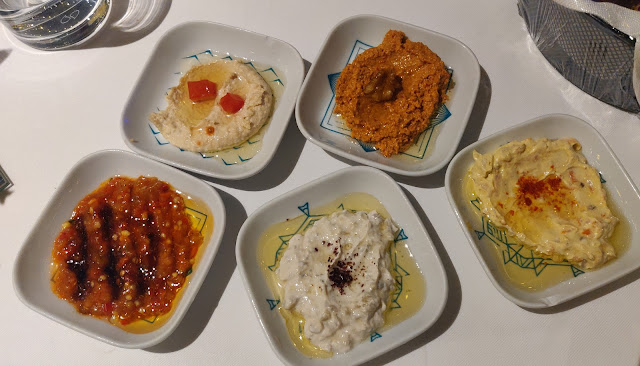In my travelogue of Turkey, I briefly touched upon Turkish food. But there have been quite a few queries asking for details on the cuisine and the various dishes that we tasted there. The need for a separate post about Turkish food stems from that.
 |
| Adana Kebap Platter in Istanbul |
My earlier exposures to Turkish food were in Hyderabad. Hyderabad has a Turkish Consulate fostering closer ties of that nation with our city. The erstwhile rulers the Nizams had a deep connection with Turkey and there were many marriages between the Turkish royals and the Nizam’s family. The Consulate does an annual Turkish festival in well-known hotels in Hyderabad, usually flying down chefs from Turkey. I had the good fortune of attending quite a few of these, fostering an interest in me the cuisine.
 |
| Doner Sade - Istanbul (top) and Antalya |
One of the most popular snacks is Durum (doner, what we call shawarma rolls here. There are usually two versions Tavuk (chicken) or Et (beef). A typical durum (doner) in Turkey costs Lira 40-50, about Rs 200-250, and can easily fill in for lunch. You can opt for Doner Sade where the meat is not rolled into the bread and is served separately. Some even ask for Pilaf instead of bread along with the shawarma meat.
 |
| Hummus & Kebaps on Bosphorus Cruise |
We enjoyed a full Turkish meal on the Bosphorus River Cruise in Istanbul. Here the spread started with soup, followed by mezze platters and then a huge assortment of kababs (or kebaps as they call there). Finally, there was dessert. But mostly as we toured Turkey, we found people doing their lunch with mezze, salads and kebaps.
 |
| Urfa Kebap |
Among the kebaps, the most famous is Adana kebap. A long sheekh of beef is served with bulger (a cereal popular here), salads, and often a large piece of smoked chili. A variant Urfa Kebap is less spicy. Chicken lovers usually go for Chicken Shish. Kebaps are served with bulger, vegetables and dips. You can substitute it with Turkish bread or French fries.
 |
| Isgara Kofte (Top) and a Street Side Kebap Place in Istanbul |
Kofte or meatballs is another popular food. Izgara Kofte is juicy grilled meatballs with little spices again served with salad and bulger or French fries. We loved these at a small place next to our hotel in Istanbul and often went back for the food.
 |
| Dolma (top), Beef Stew (Middle) and Mezze Platter |
The cheese, salads, and cold cuts in the buffets were often meals by themselves. At least three varieties of olives used to be there along with lots of vegetables. Among the cooked dishes were stews, eggplant is extremely popular here, but we enjoyed the Chicken and Fish stews also. We encountered the famed Dolmas (stuffed vegetables) in very few places. Our hotel at Kusadasi served the best dinner buffet of the trip with the food very local, while the breakfast at Hilton Istanbul was sumptuous. The salad bar at the Kusadasi dinner buffet had more than twenty varieties of salads.
 |
| Simit Stall (top), Simit (middle) and Kumpir Stall in Istanbul |
The most popular street food seemed to be Simit, a donut type of bread served with chocolate and other dips. Kumpir is another common street food where baked potatoes are stuffed with vegetables, sauces and even meat.
 |
| Pide Beef (top), Cured Meat (middle) and Pide shop in Cappadocia |
Turkish are fond of the local pizzas – called Pide or Lahmacun here. The pides are long flatbreads and can have toppings such as beef, cheese, or vegetables. In Cappadocia, we went to a village-style pide shop and witnessed how they make the pide. The pides in this area are very long and cut into pieces before they are served. One pide, good enough for a couple of people cost Lira 50 (Indian Rs 225).
 |
| Gozleme |
In Antalya, very near the Duden waterfalls, we tried Gozleme, meat mince stuffed parathas very similar to our Moglai Paratha or Baida Roti. The preparation is also like these except for a little olive oil used instead of oil, and the mince is almost bereft of spices.
 |
| Baklava (top) and Baklava varieties in a shop in Taksim |
Regarding sweets, everyone knows about Baklava. The usual baklavas found on street corners are simple and without any toppings. But the main shops have many variants of baklava with different shapes and toppings. More popular is Turkish Delight, a slightly chewy sweet from Ottoman heritage available in many variants. Istiklal Street near Taksim Square has the best baklava and Turkish Delight shops, having more than a dozen of each delicacy. But the prices are the most expensive here.
Turkish Ice cream is popular, not just because of its taste, but also for the theatrics of the ice cream vendor as he serves them. I had experienced it in one of the Turkish festivals in Hyderabad, and again went for it in the busy Sultanahmet area of Istanbul. Dondurma as it is known has a special resin named Mastik added to it, which gives a hard and thick texture.
 |
| Turkish Tea |
The Turkish love their tea and coffee served in all restaurants including lunch and dinner places. The coffee is extremely flavourful often a little bitter. Some places serve a small piece of chocolate to chew with the coffee. This is one thing that one needs to pick up for bringing it to India.
Also Read: Turkey Travelogue











































